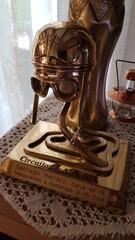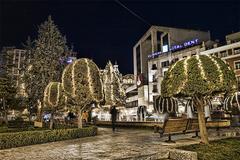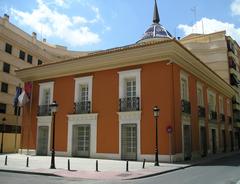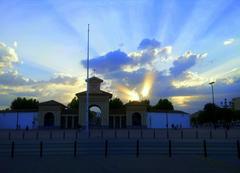
Plaza del Altozano Albacete: Visiting Hours, Tickets, and Historical Sites Guide
Date: 04/07/2025
Introduction
Plaza del Altozano sits at the historic and cultural core of Albacete, Spain. Revered as the city’s “kilometer zero,” it is a dynamic crossroads of centuries-old heritage, impressive architecture, and vibrant urban life. The square’s evolution from the 16th-century “plaza del Arrabal” to its present-day status as a civic landmark has mirrored Albacete’s own growth. Today, it is encircled by monumental buildings like the Gran Hotel de Albacete, Banco de España, and the Municipal Palace, which houses the Museo Municipal de Albacete. The plaza is also renowned for its public art, annual festivals, and as the location of the Refugio Antiaéreo del Altozano—a preserved Spanish Civil War air-raid shelter.
This comprehensive guide covers the plaza’s layered history, architectural highlights, practical information on visiting hours and ticketing, accessibility, guided tours, nearby attractions, and travel tips to enhance your visit. Whether you are a history aficionado, a cultural explorer, or a casual traveler, Plaza del Altozano offers an immersive introduction to the spirit of Albacete.
For official updates and planning resources, consult the Albacete Tourism Site, Museo Municipal de Albacete, and AlbaceteGuía.
Table of Contents
- Introduction
- Historical Overview
- Monuments and Symbolism
- Visiting Plaza del Altozano
- Nearby Attractions
- Urban Layout and Connectivity
- Name Changes and Identity
- Preservation and Modern-Day Role
- Frequently Asked Questions (FAQ)
- Visuals and Media
- Internal and External Links
- Refugio Antiaéreo del Altozano
- Summary and Final Recommendations
- References
Historical Overview
Origins and Early Development
Dating to the late 16th century, Plaza del Altozano was first known as “plaza del Arrabal,” sitting on the outskirts of medieval Albacete. Its civic importance grew with the establishment of the San Agustín and Justinianas convents in the 1570s. By 1767, the plaza was a central meeting point at the intersection of the city’s major thoroughfares.
Nineteenth-Century Transformations
The 19th century marked a period of significant change. Royal visits, such as King Ferdinand VII’s in 1814, elevated its profile. The plaza’s name reflected shifting political tides, moving from “Plaza del Progreso” to “Plaza del General Espartero.” In 1888, it became the first public space in Spain illuminated by electric lighting, reinforcing Albacete’s innovative character. The square was officially designated as the city center in 1903, and the Ayuntamiento relocated there in 1905.
Architectural Evolution and Urban Renewal
During the 20th century, the plaza underwent further transformation. Noteworthy buildings from this era include the Gran Hotel de Albacete (1915), Banco Central (1926), Cine Capitol (1933), and Banco de España (1936). The 1950s saw the addition of the Altozano gardens, a central fountain, and the installation of the Bicha de Balazote sculpture, all of which define the plaza’s current aesthetic.
The Plaza During the Spanish Civil War
Albacete’s strategic significance during the Spanish Civil War (1936–1939)—serving as the headquarters of the International Brigades—brought aerial bombings to the city. In response, the Refugio Antiaéreo del Altozano was built beneath the square to protect civilians, a legacy that endures as a site of historical memory.
Monuments and Symbolism
The plaza’s gardens, established in 1843, are Albacete’s oldest cultivated green space. Key monuments include:
- Monument to the Cuchillero: Honoring the city’s famed cutlery industry.
- Bicha de Balazote: A replica of a renowned Iberian sculpture, linking Albacete to its archaeological heritage.
- Gran Dama Oferente: Symbolizing the city’s prehistoric roots.
- Contemporary Additions (2023): Monuments to filmmaker José Luis Cuerda and the modern “Albacete” sculpture.
Visiting Plaza del Altozano
Visiting Hours
- Plaza del Altozano: Open public space, accessible 24/7.
- Museo Municipal de Albacete: Tuesday to Sunday, 10:00 AM–2:00 PM and 4:00 PM–7:00 PM.
- Filmoteca de Albacete: Check official website for screening times.
Ticket Information
- Plaza and gardens: Free entry.
- Museums and exhibitions: May require tickets. Visit their official sites for current prices.
Accessibility
- Wheelchair-accessible surfaces and ramps.
- Nearby public transport and parking.
- Most public buildings in the plaza are accessible.
Guided Tours and Special Events
- Guided tours available via the official Albacete tourism office.
- The plaza hosts the Fiesta del Libro, concerts, markets, and community festivals throughout the year.
Travel Tips
- Visit during early morning or late afternoon for optimal lighting and fewer crowds.
- Explore adjacent streets: Calle Marqués de Molins, Paseo de la Libertad, and Calle Ancha.
- Enjoy regional cuisine at nearby cafés and restaurants.
Nearby Attractions
- Palacio de Justicia: Headquarters of the Tribunal Superior de Justicia de Castilla-La Mancha.
- Museo Municipal de Albacete: Exhibits on local history and art.
- Filmoteca de Albacete: Cinema and cultural events.
- Pasaje de Lodares: Historic shopping arcade.
- Biblioteca Tomás Navarro Tomás: Located in the historic Chalé Fontecha.
Urban Layout and Connectivity
Plaza del Altozano forms a central node, bordered by Calle Marqués de Molins to the south and Paseo de la Libertad to the north. It connects easily with Calle San Agustín (east) and Calle Martínez Villena (west), anchoring Albacete’s historic core.
Name Changes and Identity
Reflecting the city’s shifting identity, the plaza has been known as Plaza del Arrabal, Plaza del Progreso, Plaza del General Espartero, Plaza de Gabriel Lodares, Plaza del Caudillo, and, since the late 20th century, Plaza del Altozano.
Preservation and Modern-Day Role
Ongoing restoration—such as the recent cleaning of the Banco de España façade—demonstrates Albacete’s dedication to preserving its architectural heritage. The plaza remains a venue for civic life, cultural programming, and social gatherings.
Frequently Asked Questions (FAQ)
Q: What are Plaza del Altozano’s visiting hours?
A: The plaza is open 24/7. Museums and attractions have set hours—refer to official websites for details.
Q: Is there an entrance fee to the plaza?
A: Access to the plaza and gardens is free. Some museums or exhibitions may charge admission.
Q: Are guided tours available?
A: Yes, through the official tourism office and during special events.
Q: Is the plaza accessible?
A: Yes, it features ramps and smooth surfaces.
Q: What events take place at Plaza del Altozano?
A: The annual Fiesta del Libro, concerts, markets, and various community festivals.
Visuals and Media
For virtual tours, high-quality images, and more, visit the official Albacete tourism website. Alt text for images should include: “Plaza del Altozano visiting hours,” “Albacete historical sites,” and “Plaza del Altozano tickets.”
Refugio Antiaéreo del Altozano
Historical Background
Built in 1937 beneath Plaza del Altozano, the Refugio Antiaéreo del Altozano was constructed during the Spanish Civil War to protect civilians from aerial bombardment, as Albacete was a strategic hub for the Republican side (memoriademocraticaclm.uclm.es).
Architectural Features
- Square layout (20 x 20 meters), with thick walls and perimeter corridors.
- Four entrances for efficient evacuation.
- Original benches and painted safety instructions remain intact (museumspedia.net).
Role During the Spanish Civil War
The shelter was the city’s principal public refuge, accommodating thousands during air raids (albaceteguia.com).
Post-War Evolution and Restoration
After 1953, the shelter was used for mushroom cultivation until restoration began in 2000. In 2007, it reopened as the Center for Peace Interpretation and the city’s Tourist Office, with further enhancements completed in 2020 (albaceteguia.com).
Cultural and Educational Significance
Now a center for historical education and memory, the shelter features exhibitions curated by the Municipal Archive, chronicling Albacete’s wartime past (wikipedia.org).
Practical Visitor Information
- Location: Beneath Plaza del Altozano, entrance next to the Tourist Office.
- Guided Tours: By appointment only.
- Monday–Friday: 10:00, 11:00, 12:00, 16:00, 17:00
- Saturday: 10:00–13:00, 16:00–18:00
- Sunday/Public Holidays: 10:00–13:00
(turismoenalbacete.com)
- Tickets: Free
- Booking: Phone +34 967 630 004 or email [email protected]
- Accessibility: Recent renovations include elevators and accessible restrooms
- Photography: Permitted; be mindful of the site’s solemnity.
- Languages: Tours in Spanish; inquire for English options.
Visitor Experience
The shelter’s preserved features and interpretive materials create a powerful, immersive atmosphere. Recent upgrades have improved accessibility for all visitors.
Nearby Attractions
After your tour, visit nearby cultural sites such as the Museo Municipal de Albacete, the Museo Municipal de la Cuchillería, and enjoy the plaza’s cafés and events (spain.info).
Summary and Final Recommendations
Plaza del Altozano encapsulates Albacete’s historical evolution and community spirit. From its medieval origins to its modern role as a civic and cultural hub, the plaza offers visitors a tapestry of architectural styles, public monuments, and enduring social traditions. The Refugio Antiaéreo del Altozano adds a profound layer of historical memory and education.
Accessible, centrally located, and surrounded by cultural attractions, Plaza del Altozano is essential for anyone seeking to understand Albacete’s heritage. For the latest information on hours, tickets, and events, consult official resources and consider using the Audiala app for real-time updates and guided tours.
References
- Turismo Albacete
- AlbaceteGuía
- Museo Municipal de Albacete
- Memoria Democrática Castilla-La Mancha
- Wikipedia: Refugio Antiaéreo del Altozano
- Diputación de Albacete
- La Tribuna de Albacete
- El Digital de Albacete
- Spain.info
All hyperlinks direct to referenced sources for further reading and verification.







